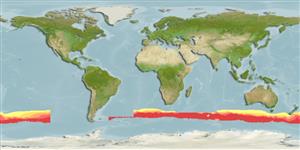Teleostei (teleosts) >
Argentiniformes (Marine smelts) >
Bathylagidae (Deep-sea smelts)
Etymology: Bathylagus: Greek, bathys = deep + Greek, lagos = hare (Ref. 45335).
Environment: milieu / climate zone / depth range / distribution range
Ecology
Marine; bathypelagic; depth range 0 - 2600 m. Temperate; 36°S - 58°S
Southern Ocean: Scotia Sea, and Crozet Is., Kerguelen Is., Macquarie I. (Ref, 45488). Also known from the central South Pacific and the southeast Atlantic.
Size / Weight / Age
Maturity: Lm ? range ? - ? cm
Max length : 16.0 cm SL male/unsexed; (Ref. 5002)
Diurnal migration. Feeds mainly on copepods, appendicularians, euphausiids, pteropods, chaetognaths and cephalopods (Ref. 45488).
Life cycle and mating behavior
Maturity | Reproduction | Spawning | Eggs | Fecundity | Larvae
Gon, O., 1990. Bathylagidae. p. 107-110. In O. Gon and P.C. Heemstra (eds.) Fishes of the Southern Ocean. J.L.B. Smith Institute of Ichthyology, Grahamstown, South Africa. 462 p. (Ref. 5002)
IUCN Red List Status (Ref. 130435: Version 2024-2)
Threat to humans
Harmless
Human uses
Fisheries: of no interest
Tools
Special reports
Download XML
Internet sources
Estimates based on models
Preferred temperature (Ref.
123201): 1.4 - 7.3, mean 2.4 °C (based on 157 cells).
Phylogenetic diversity index (Ref.
82804): PD
50 = 0.5078 [Uniqueness, from 0.5 = low to 2.0 = high].
Bayesian length-weight: a=0.00525 (0.00219 - 0.01260), b=3.01 (2.80 - 3.22), in cm total length, based on LWR estimates for this (Sub)family-body shape (Ref.
93245).
Trophic level (Ref.
69278): 3.2 ±0.4 se; based on size and trophs of closest relatives
Resilience (Ref.
120179): Medium, minimum population doubling time 1.4 - 4.4 years (Preliminary K or Fecundity.).
Fishing Vulnerability (Ref.
59153): Low vulnerability (10 of 100).
